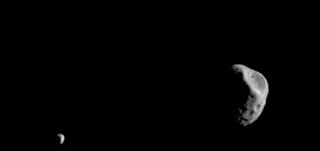Were the Mars moons Phobos and Deimos born from another shattered moon?
Their origin is perplexing.

The moons of Mars, Phobos and Deimos, might have both arose from the remains of a larger moon that once orbited the Red Planet, a new study finds.
The origins of Phobos and Deimos remain uncertain. While their misshapen forms and their cratered surfaces suggested they were asteroids captured by the gravitational pull of Mars, previous research questioned this scenario because of the moons' near-circular orbits around the Red Planet's equator. If these moons really were captured asteroids, computer simulations found that they'dlikely have more irregular orbits.
As such, researchers have also proposed another idea: Phobos and Deimos could have formed from a disk of rock and dust that may have once orbited a newborn Mars. However, this scenario faces a number of challenges of its own.
Related: 7 biggest mysteries of Mars
For example, in order to form two moons of such sizes and distances from Mars, prior studies suggested a large, massive disk was necessary. Given such a disk, the formation "of a single larger moon is much more likely, similar to the Earth's moon," study lead author Amirhossein Bagheri, a planetary science researcher at the Swiss Federal Institute of Technology in Zürich, told Space.com.
In addition, previous studies have suggested that such a moon-forming disk likely originated from a cosmic impact that also created the gigantic Borealis basin in the northern lowlands of Mars, which covers two-fifths of the Red Planet's surface. However, Bagheri noted, the impact that formed that basin is thought to have happened in the very early stages of solar system formation. If Phobos was that old, based on what researchers know about its orbit, "it should have already crashed on Mars, and we would've not been able to see it in the present day," he noted.
Now Bagheri and his colleagues suggest a new possibility — that Phobos and Deimos both originated from the remnants of a shattered moon.
Get the Space.com Newsletter
Breaking space news, the latest updates on rocket launches, skywatching events and more!
The scientists analyzed the latest data about Mars, Phobos and Deimos, including Martian seismic data from NASA’s InSight lander currently operating on the Red Planet, to see how these bodies might have evolved over time. They found the orbits of the moons might have intersected at recently as 1 billion to 2.7 billion years ago, suggesting their progenitor was a larger moon that disintegrated, likely because of a giant impact.
"I find the idea that Mars used to have a larger moon, which was hit by one of the many objects that has been rushing towards it, quite exciting and surprising," Bagheri said.
The remaining debris from this impact could have rained down on the Red Planet. "Mars's surface is peppered with impact craters and many of them are estimated to have ages within the time period we compute for the disruption event of the earlier moon," Bagheri said.
The scientists noted that whereas Deimos is very slowly receding from Mars, Phobos is continuing to spiral towards the Red Planet. They suggested it would likely either impact with Mars or get torn apart by its gravitational pull in 39 million years.
Future research can learn more about this theoretical moon via closer looks at Phobos and Deimos, Bagheri said. He noted that new insights may come from the upcoming Martian Moons Exploration mission from Japan's space agency, which aims to collect samples from Phobos.
The scientists detailed their findings online Feb. 22 in the journal Nature Astronomy.
Originally published on Space.com.
Join our Space Forums to keep talking space on the latest missions, night sky and more! And if you have a news tip, correction or comment, let us know at: community@space.com.

Charles Q. Choi is a contributing writer for Space.com and Live Science. He covers all things human origins and astronomy as well as physics, animals and general science topics. Charles has a Master of Arts degree from the University of Missouri-Columbia, School of Journalism and a Bachelor of Arts degree from the University of South Florida. Charles has visited every continent on Earth, drinking rancid yak butter tea in Lhasa, snorkeling with sea lions in the Galapagos and even climbing an iceberg in Antarctica. Visit him at http://www.sciwriter.us
